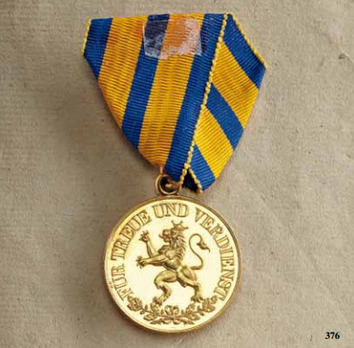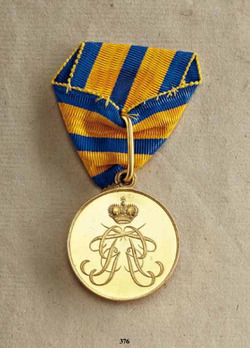Schwarzburg Duchy Honour Cross, Civil Division, Gold Medal
CATEGORY: Version
SKU: 01.SBR.0101.105.01.000
Estimated market value:


Estimated market value:
A smooth circular medal with raised edges, constructed of silver gilt. The obverse features an upright crowned lion facing towards the viewer’s left, with the circular inscription ‘FÜR TREUE UND VERDIENST’ (‘for loyalty and merit’) and two crossed oak leaves at the bottom, tied with a ribbon. The reverse features the crowned, mirrored, and intertwined monogram ‘FG’. On a loop for suspension, on a yellow ribbon with a blue centre stripe and blue side stripes. 17 grams.
The Schwarzburg Duchy Honour Cross was founded on May 20, 1853 by Prince Friedrich Günther of Schwarzburg-Rudolstadt. It was originally awarded as a meritorious service award. On June 28, 1857, the decoration became a shared order with the Princely House of Schwarzburg-Sondershausen. The order originally consisted of three cross grades and a merit medal.
In 1866, the Merit Medal was divided into two grades, the Gold Merit Medal and the Silver Merit Medal.
As of 1870, crossed swords could be added to the I Class Honour Cross, II Class Honour Cross, and III Class Honour Cross. The swords became a possible addition in reaction to the onset of the Franco-Prussian War of 1870/71. The awards issued with crossed swords were conferred in recognition of military merit in wartime.
In 1873, the order was expanded to include four cross grades and a silver merit medal.
As of 1901, the I Class Honour Cross could be awarded with or without a crown.
In 1911, the decorations of both princely houses were harmonised so that they were produced in uniform sizes.
As of 1914, swords could once again be added to all grades of the order to denote wartime military merit.
In 1914, the design of the Silver Merit Medal was slightly altered and the date '1914' was added to the reverse of the medal. As of 1915, a golden oak leaf could be added to the suspension of the cross grades as well as the silver merit medal. The addition of an oak leaf denoted that the wearer had rendered outstanding service in the army. It could also be awarded to individuals who played a significant role in preparing for the war. The oak leaf features the date '1914/15' on the obverse.
As of 1916, the Silver Merit Medal was awarded on a blue ribbon with a red stripe to military personnel in a non-combatant role.

Comments
Sign in to comment and reply.


Scroll Top